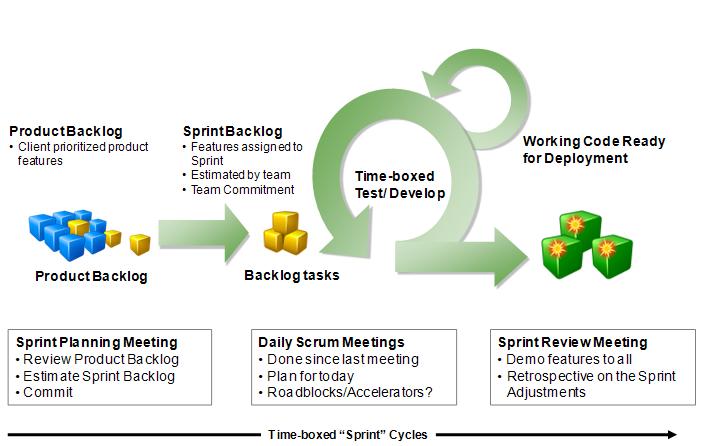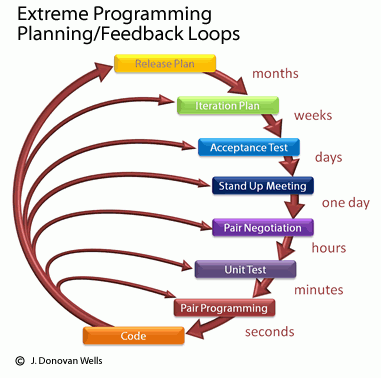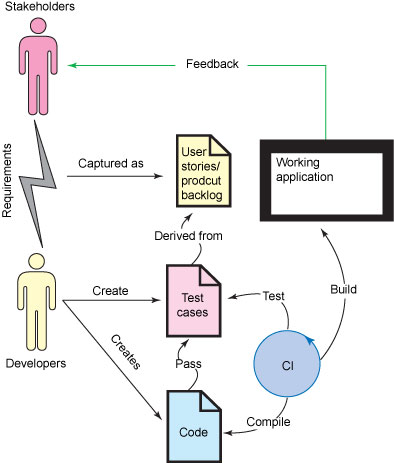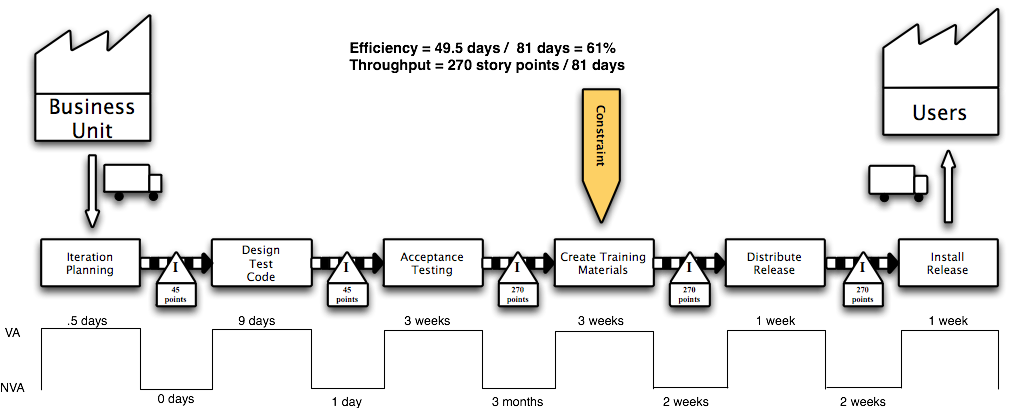CSC/ECE 517 Fall 2009/wiki3 7 dEaN
What are agile practices
One can summarize the Agile practices in a nutshell by asserting the following characteristics:
- Agile methodology could be described as "iterative" and "incremental"
- Each iteration (also known as sprints or time-limited modules or timeboxes) involves a team working through a full software development cycle. In other words, each iteration has it own self-contained stages of analysis, design, production, testing and documentation.
- An iteration may not warrant a market release. Elaborating further: in theory, a new software release could be done at the end of each iteration, but in practice the progress made in one iteration may not be worth a release and it will be carried over and incorporated into the next iteration. The project's priorities, direction and progress are re-evaluated at the end of each iteration
- Goal is to have an available release (with minimal bugs) at the end of each iteration
- Teamwork, collaboration, and process adaptability throughout the life-cycle of the project are other important features in Agile development
- Tasks are broken into small increments with minimal planning. This is achieved through iterations
- Project requirements and solutions evolve through collaboration between self-organizing cross-functional teams. Agile teams tend to work as a team in a bullpen - an open floor-plan work area that makes face-to-face communications easy. In a brief session, team members report to each other what they did yesterday, what they intend to do today, and what their roadblocks are
- Agile emphasizes working software as the primary measure of progress. A software project is often measured with the five dimensions - duration, risk, novelty, effort, and interaction
- Rapid delivery of high-quality software is achieved, since the prototypes are delivered in increments, thanks to the iterative approach
- Agile methods are adaptive as compared to predictive when contrasted with other plan-driven methodologies
| The Agile Manifesto is based on the following principles: |
|---|
| 1. Customer satisfaction by rapid, continuous delivery of useful software |
| 2. Working software is delivered frequently (weeks rather than months) |
| 3. Working software is the principal measure of progress |
| 4. Even late changes in requirements are welcomed |
| 5. Close, daily cooperation between business people and developers |
| 6. Face-to-face conversation is the best form of communication (co-location) |
| 7. Projects are built around motivated individuals, who should be trusted |
| 8. Continuous attention to technical excellence and good design |
| 9. Simplicity |
| 10. Self-organizing teams |
| 11. Regular adaptation to changing circumstances |
Example of agile practices
- It appeared under different names and flavours such as: Scrum (in management), Crystal Clear, Extreme Programming (XP), Adaptive Software Development, Feature Driven Development, and DSDM.
| Scrum is an iterative incremental framework for managing complex work (such as new product development) commonly used with agile software development. One agile software solution is ScrumWorks Pro, a Scrum-specific project management tool. http://agilemethodology.org/agile-software/ |  |
| Extreme Programming (XP) is a software development methodology which is intended to improve software quality and responsiveness to changing customer requirements. As a type of agile software development, it advocates frequent "releases" in short development cycles (timeboxing), which is intended to improve productivity and introduce checkpoints where new customer requirements can be adopted. |  |
Agile methodology lifecycle in pictures
 |
 |
 |
A brief overview on other methodologies
- Waterfall model - this is the classic SDLC
- RAD
- Prototyping
- Spiral
Scenarios where other methodologies are feasible but not complete
The waterfall model is the most structured of the methods, stepping through requirements-capture, analysis, design, coding, and testing in a strict, pre-planned sequence. Progress is generally measured in terms of deliverable artifacts: requirement specifications, design documents, test plans, code reviews and the like.
The main problem with the waterfall model is the inflexible division of a project into separate stages, so that commitments are made early on, and it is difficult to react to changes in requirements. Iterations are expensive. This means that the waterfall model is likely to be unsuitable if requirements are not well understood or are likely to change in the course of the project.
How can Agile complement other design methodologies in such scenarios
- For some scenarios, Waterfall model was too slow and did not comfortably accommodate the ways systems/software engineers actually work best. Agile, put simply, is where software is developed progressively with each new release adding more capabilities.
- Agile methods have features in common with RAD.
- Agile development differs from other development models: in this model time periods are measured in weeks rather than months and work is performed in a highly collaborative manner. Most agile methods also differ by treating their time period as a timebox.
- In Agile methodology, the emphasis is on obtaining the smallest workable piece of functionality to deliver business value early, and continually improving it and adding further functionality throughout the life of the project. If a project being delivered under the waterfall method is cancelled at any point up to the end, there is nothing to show for it beyond a huge resources bill. With the agile method, being cancelled at any point will still leave the customer with some worthwhile code that has likely already been put into live operation.
- RAD and Agile are both short iterative processes that deliver a reduced feature set.
- RAD = prototypes, reduced features.
- Agile = iterations.
- Traditionally the rapid application development approach involves compromises in usability, features, and/or execution speed. Agile on the other hand doesn't aim to achieve that. The iterations aren't prototypes, rather, each iteration introduces changes and/or enhancements into the product and these are reviewed by all parties involved.
- We use Agile methodologies but still use other processes around it, documentation, system and user acceptance testing, deployment processes.
- The advantage of Agile based approach is modification of the requirements which is often applicable in a fast changing environment - one where the business needs to be reactive to the market conditions and/or competition.
- Long term plans often fail at seams (in such environments) because once a product is released after the many months of development, it may be exactly as per specs but is no longer relevant in the market conditions of the day.
- Another advantage of frequent iterations is that you expose the client to the new features gradually. They can provide feedback much quicker which can resolve any misconceptions that may have been harboured in the requirements.
- The difference here between RAD and Agile is that in RAD you do not have immediate feedback from the client between iterations. It is up to the developers to split the development into iterations that are useful and logical. For example, you'd probably split 1 into some more iterations, for example, add an advanced search, etc. same with Iteration 2, add validation, feedback, etc.
Overview of work in this area
Research results and experience reports
Current research
Large scale agile software development remains an active research area.
Conclusion
Agile methodology adheres to a rapid prototyping approach that builds the software in small bursts or sprints (iterations). Such an approach can complement other conventional software development life-cycle models whe
Agile home ground:
* Low criticality[clarification needed] * Senior developers * Requirements change often * Small number of developers * Culture that thrives on chaos[clarification needed]
Plan-driven home ground:
* High criticality[clarification needed] * Junior developers * Requirements do not change often * Large number of developers * Culture that demands order
Appendix
- Adaptive methods focus on adapting quickly to changing realities. When the needs of a project change, an adaptive team changes as well.
- Predictive methods, in contrast, focus on planning the future in detail. A predictive team can report exactly what features and tasks are planned for the entire length of the development process.